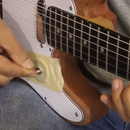Introduction: 10 Maker Garage Improvement Ideas
If you're moving into a new garage, this is a great time to make improvements to help you make stuff! Here are 10 ideas that I did with my own space, and that could help you too.
Step 1: Coat the Floors
The first photo is the garage before putting a coating on it, the second is after. This is a huge improvement both in how it looks and feels, and the ability to keep it clean. I hired a local company to apply something called Spartacote, but there are DIY options available as well.
Step 2: Plan
With the floors coated, I made a plan where I wanted all my benches and tools. The idea was to be able to park a car on the other side, which I did—once at least. I also mapped out where I wanted extra power outlets, as options were extremely limited. Having a plan let me use space wisely, and place stuff where I wanted when I actually had help from the movers.
Step 3: More Power!
As mentioned, power outlets were limited in this garage, so I hired a company to put in extras. They used "quad boxes" and two 20 amp circuits so that I'd have plenty of power and outlets for my machinery.
Step 4: Extra Lighting
Given my house's concrete block construction, they used metal conduit to run the wires. These made a perfect mount for clamp lights, which I secured with the help of zip ties.
I also purchased a desk lamp style light that clamps on one of my workbenches. This will be great for lighting up precision soldering work, as well as my milling machine.
Step 5: Pegboard
I installed pegboard for easy tool access. Being able to grab a tool whenever it's needed is great, and I made custom spacers in order to allow it to fit over the conduit. Tapcon screws were used to fasten things to the concrete block, which worked quite nicely.
Once up, there was the job of figuring out where everything would actually go, but after some rearranging, I got most of my manual tools to fit. For the power tools, I decided to hang another piece of pegboard, allowing me to get my most important items out in the open
Step 6: Shelf for Paint and Stain
The idea was that this would act like a bookshelf, putting everything on display for me to see and pick out.
I sanded it and drilled holes for my Tapcon screws, the same kind that I used with the pegboard, then attached screws to the bottom.
Step 7: Whiteboard
For all my ideas and hardware store lists, this makes a great display.
Step 8: Hooks
Installed a hook assembly. Great for keeping brooms etc off the floor.
Step 9: Parts Storage
For larger stuff, the bins shown in the first image work pretty well and are stackable. For the smaller parts, I used plastic storage boxes from Harbor Freight. I made an assembly for those out of plywood and 2 x 3 studs to allow me to pull them out easily.
Step 10: Clean and Configure Tools
After all this work, you might as well get things clean, and have your tools working as they should!
Step 11: Bonus: Space for StrandBeest
You need space for your robotic pets of course! Video is from it walking around in its former garage. You can see more of my 'beests on this YouTube playlist.

Participated in the
Workshop Hacks Challenge 2017













